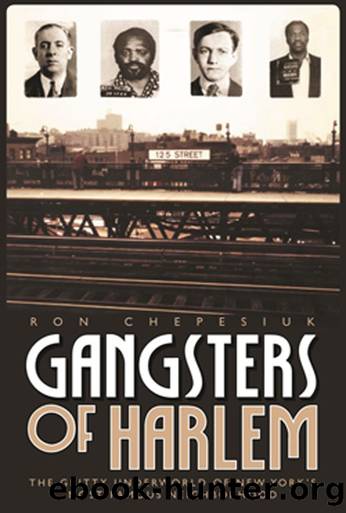Gangsters of Harlem by Ron Chepesiul

Author:Ron Chepesiul [Chepesiuk, Ron ]
Language: eng
Format: epub
ISBN: 9781569804032
Publisher: Barricade Books
The Bank Of Harlem
NICKY âMR. UNTOUCHABLEâ Barnes is now out of prison, but remains deep in the Federal Witness Protection Program. Many people with long memories still want to see him dead. On the street and in Harlem, Barnesâs reputation is soaked with slime; nobody likes a stool pigeon. F.E.D.S. magazine asks Guy Fisher, âHow many guys did Barnes tell on? Was it over a hundred?â The former Harlem gangster, who got a life sentence plus 53 years, answered: âI donât know if it was that many, but he told on guys in the joint and told whatever he could think of. I can go to jail or walk down my block without hiding my face. Nick has to leave out the back room or sneak around whatever he goes. Itâs a big difference, because your manhood doesnât have a price on it.â
Even among Harlem gangsters who have paid their debt to society, Barnes gets no respect. This includes Richard âPee Weeâ Kirkland, a contemporary of Barnes who is just as big a Harlem legend as Mr. Untouchable. Frank Lucas, one of the major Harlem drug traffickers of the late 1960s and early â70s, gave this assessment of Kirkland: âPee Wee handled whatever he did well. He was a superstar. Thatâs all I can tell you.â
Kirkland described Mr. Untouchable as âthe biggest snitch New York has ever seen,â explaining, âAll the gangsters that were under Nick were strong. None of them were weak. Nick turned out to be the weak one. Man, he destroyed a lot of peopleâs lives.â
Kirkland laments that no one today supports the unwritten law of the streets, âDeath before Dishonorâ and that âthere are no codes, no principles, and no rules.â Kirkland does not talk about the narcotic poison, the kilos of heroin that he, Barnes, and the other Harlem gangsters of the 1960s and early 1970s dumped on the streets. In 1968, the New York Joint Legislative Committee on Crime provided statistics that revealed the negative economic impact organized crime had on Harlem and the cityâs two other main slum areas, the South Bronx and Bedford-Stuyvesant. The Committee found the annual impact to be $343 million, which was about $70 million more than New York State spent on welfare each year.
âThe flow of money from the ghetto to organized crime is so great that there can be little meaningful economic improvement in New York Cityâs ghettos until it is stopped,â State Senator John Hughes of Syracuse, Chairman of the State Legislative Crime Committee, told the New York Times.
Criminal activity in Harlem and the other ghettos in the late 1960s, moreover, had an indirect cost. A study by the State Narcotic Addiction Control Commission of 3,000 addicts found that an addict stole about $50,000 worth of property annually to support a drug habit that cost, on average, about $30 a day.
Kirkland, once known as âthe Bank of Harlem,â was an outof-the-stratosphere talent on the basketball court. But he took the trip down the road to the gangster life rather than the NBA and spent many of his prime years languishing in prison.
Download
This site does not store any files on its server. We only index and link to content provided by other sites. Please contact the content providers to delete copyright contents if any and email us, we'll remove relevant links or contents immediately.
| African Americans | Civil War |
| Colonial Period | Immigrants |
| Revolution & Founding | State & Local |
Cat's cradle by Kurt Vonnegut(15103)
Pimp by Iceberg Slim(14221)
4 3 2 1: A Novel by Paul Auster(12224)
Underground: A Human History of the Worlds Beneath Our Feet by Will Hunt(11983)
The Radium Girls by Kate Moore(11870)
Wiseguy by Nicholas Pileggi(5614)
Perfect Rhythm by Jae(5279)
American History Stories, Volume III (Yesterday's Classics) by Pratt Mara L(5214)
The Fire Next Time by James Baldwin(5202)
Paper Towns by Green John(5026)
Pale Blue Dot by Carl Sagan(4861)
A Higher Loyalty: Truth, Lies, and Leadership by James Comey(4800)
The Mayflower and the Pilgrims' New World by Nathaniel Philbrick(4379)
The Doomsday Machine by Daniel Ellsberg(4377)
Killers of the Flower Moon: The Osage Murders and the Birth of the FBI by David Grann(4350)
The Sympathizer by Viet Thanh Nguyen(4264)
Too Much and Not the Mood by Durga Chew-Bose(4232)
The Borden Murders by Sarah Miller(4190)
Sticky Fingers by Joe Hagan(4068)
